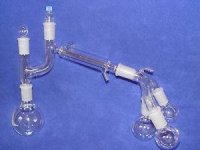GW,
is that glassware rated for high vacuum? It is a very large glass vessel to be puling that hard. hoping you checked before recommending it...
I bet we are going to start seeing a bunch of implosions/explosions with all these amateur non-chemists playing with cheap glassware at high vacuum.
lets be safe about this
I'd be surprised if the Eden labs vessel could maintain the vacuum required....maybe enough to distill, and maybe for a while, but eventually that large bulb could implode. Scary.....
I agree fully with Regis. When buying glassware make sure it's rated for vacuum as many of these setups are not, which is reflected in price. I'm told the longer annealing time increases the price and strengths.



